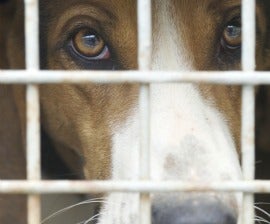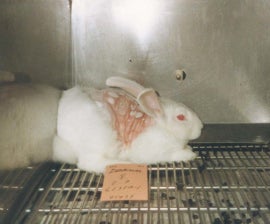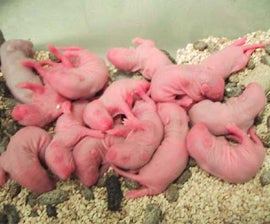-

HSI has helped put an end to 12-month pesticide-poisoning tests using dogs in Europe and the United States. Shutterstock
-

Rabbit “lethal dose” (LD50) skin tests on the way out in Europe thanks to HSI. Photobucket
-

Reproductive and developmental toxicity studies consume between 1,300 and 2,600 mother and baby rats per chemical tested. Photobucket
Pesticides, from weed killers and rat poison to insect repellant and cleansers that claim to “kill germs,” are among the most heavily animal-tested products in existence. Government regulations sometimes require dozens of different animal-poisoning tests to assess the safety of a single new pesticide to market.
Some tests use thousands of animals at a time, while others are repeated two or even three times using different animal species and/or routes of chemical administration (e.g., oral force-feeding, forced inhalation and skin application). This means terrible suffering and death for upwards of 10,000 of rabbits, rodents, birds, fish, and even dogs, for every new pesticide.
HSI’s Science Team is working around the globe in cooperation with companies and government authorities to replace outdated pesticide testing requirements with the latest “3R best practices”—tests that replace, reduce or refine animal use while continuing to protect human health and the environment from toxic hazards—and we’re making unprecedented progress.
Europe leads the way
Between 2009 and 2012, HSI led a successful scientific lobbying campaign in Europe to dramatically reduce animal testing requirements for biocides (non-food pesticides) and plant protection products (food-use pesticides). EU directives governing these product sectors were adopted in 1991 and 1998, respectively, making them 15-20 years out of date with 3R best practices. But when the new EU biocides regulation was published in June 2012, more than 80 technical amendments proposed by HSI’s Science Team had been taken up. Collectively, these amendments have the potential to reduce the number of animals used to test a new biocidal active substance by an unprecedented 40 to 50 percent compared to previous requirements—making this the largest one-time regulatory animal test reduction ever achieved.
The process for revising EU testing requirements for food-use pesticides is also nearing completition, with many of the same HSI-promoted 3R best practices having been taken up.
Donate to support HSI’s campaign to end animal testing around the world.
Exporting best practices globally
Through our network of country offices, HSI is now working to extend the animal-saving achievements made in Europe to other key global markets. In India, we’re working to revise legislation dating back to the 1970s and bring both data requirements and test guidelines into the 21st century. In the United States, HSI and others have already made some progress convincing the Environmental Protection Agency to take up a number of animal reduction measures.
